“This is something that arises from the internal dynamics of the atmosphere,” said Pedram Hassanzadeh, co-author of a study about the discovery in the open-access journal AGU Advances. “We were playing with some new equations that we had derived for the atmosphere’s turbulent circulation, and we found they predicted the possibility of natural periodicity in the Southern Annular Mode (SAM). We were skeptical, but we went to the observational data and we actually found it.”
Co-author Sandro Lubis said, “It was really a surprise, because it goes against the conventional wisdom that the atmosphere is all chaos and disorganization.”
SAM, which is also known as the Antarctic oscillation, is an important climate driver for Australia, New Zealand and Antarctica and has been well-studied for decades.
“It has been very important to the climate community,” said Hassanzadeh, an assistant professor of mechanical engineering and of Earth, environmental and planetary sciences at Rice. “People always look at the SAM because it affects so much in the Antarctic: the ice, the ocean, the ozone layer, almost everything. But the oscillations, which you can see in the north-south movements of the jet stream winds, happen randomly with timescales of 10-20 days.”
It was surprising to find that a simultaneous, organized oscillation occurs 10 times more slowly, he said, but the periodicity of the slower oscillation was even more surprising.
Lubis, a research scientist at Pacific Northwest National Laboratory and former postdoctoral research fellow in Hassazadeh’s lab at Rice, said the 150-day oscillation clearly influences the variability of the hemispheric-scale precipitation and ocean surface wind stress, which suggests it could have broader impacts on the weather and climate of the Southern Hemisphere and its ocean and cryosphere.
Hassanzadeh and Lubis each said the paper’s biggest impact will likely be in the arena of climate modeling.
“Significantly, we found that many state-of-the-art climate models cannot reproduce this periodicity,” Lubis said. “This helps explain some of the previously reported shortcomings of these models in simulating the SAM variability. Based on those findings, we were able to propose new metrics and ideas for evaluating how well climate models simulate the SAM and for understanding their shortcomings and potentially improving them.”
The jet stream results from two large-scale features of Earth's atmospheric circulation, the tendency for air to sink in the subtropics, about 30 degrees latitude north or south of the equator, and to rise as it nears the pole, around 60 degrees latitude. Where air sinks, pressure increases and areas of high pressure develop. Where air rises, pressure drops, resulting in areas of low pressure.
The mid-latitudes between the 60th and 30th parallels, in both hemispheres, are therefore bounded by globe-wrapping bands of low pressure on their poleward sides and high pressure on their subtropical sides. The low pressure zones correspond with strong upper-level winds known as the polar jet stream, which trace almost circular, or annular, paths around the poles.
The polar jet stream around Antarctica regularly migrates between southerly tracks that hug the icy continent and northerly tracks that cross or come near Australia, South Africa and South America. These north-south oscillations typically last about two weeks, but their timing and duration are random.
The oscillations correspond with balanced air pressure anomalies of one sign near the 60th parallel and the opposite sign near the 30th parallel. The SAM is a statistical index of these anomalies, which oscillate in a seesaw pattern, rising and falling on opposing boundaries as the westerlies move north and south.
When the SAM index is positive, the jet stream is enhanced and cold air stays bottled up around the pole. When the index is negative, atmospheric lows — and rain and storms — are more frequent in the mid-latitudes.
Hassanzadeh said the discovery of the SAM’s 150-day periodicity came from rethinking the conventional mathematical and statistical approaches to understanding atmospheric circulation.
“For whatever you’re interested in, like wind or temperature, you can reduce it to the leading pattern, the second leading pattern, the third leading pattern, and so on,” he said. “And the way this statistical analysis, called principal component analysis, has been done, the patterns are all supposed to be independent of one another.”
Based on previous studies by other groups, Hassanzadeh and Lubis thought, some of the patterns might be dependent at some lag times.
“We relaxed some of the assumptions, created a new mathematical model and then wrote a very technical paper showing that it was a better model,” Lubis said. “And at some point we looked at the model and said, ‘This says there is a periodicity. Of course, that cannot be right! But let’s go to the data and look.’”
Hassanzadeh said the 150-day periodicity occurs because the SAM’s leading patterns of north-south movements are not independent. Rather, they interact with and are acted upon by other leading wind patterns.
“The leading pattern is the SAM, the regular movement of the jet to the north or south,” Hassanzadeh said. “The second pattern is the jet stream becoming faster or slower. The way this periodicity works is that the first pattern, the SAM, reinforces itself and makes itself stronger. And the second pattern also makes the SAM stronger. But then, when the SAM becomes very strong, it starts reducing the second pattern, which in turn reinforces the SAM less.”
Hassanzadeh said the next step in the research is investigating why some state-of-the-art climate models fail to capture those interactions and the 150-day periodicity of the SAM.
“In the long run, our hope is that this new knowledge will help improve model accuracy for climate change projections,” he said.
The research was supported by the Office of Naval Research (N00014-20-1-2722), the National Science Foundation (2046309, 1921413) and the Department of Energy (DE-AC05-76RL01830). Computational resources were provided by the Extreme Science and Engineering Discovery Environment (XSEDE), the National Center for Atmospheric Research (NCAR) and the Rice University Center for Research Computing.
-30-
Peer-reviewed paper:
“The Intrinsic 150-day Periodicity of the Southern Hemisphere Extratropical Large-Scale Atmospheric Circulation” | AGU Advances | DOI: 10.1029/2022AV000833
Authors: Sandro W. Lubis and Pedram Hassanzadeh
https://doi.org/10.1029/2022AV000833
Video:
"Understanding the Southern Annular Mode (SAM)"
Australian Bureau of Meteorology
https://youtu.be/KrhWsXCB3u8
Image downloads:
https://news-network.rice.edu/news/files/2023/06/0605_SAM-fig-lg.jpg
CAPTION: Panels showing lagged composited differences for (b-d) anomalous total precipitation, (f-h) zonal wind stress, and (j-l) meridional wind stress for the Southern Hemisphere below the 20th parallel. Composites were computed by first averaging the anomalies at lags of 0, -75, or +75 days with respect to dates local maxima or minima reached, and then calculating the difference (maxima minus minima) for each lag. (Figure courtesy of Hassanzadeh Group/Rice University)
http://www.bom.gov.au/climate/sam/
CAPTION: The Southern Annular Mode (SAM) is a climate driver that can influence rainfall and temperature in Australia. The SAM refers to the (non-seasonal) north-south movement of the strong westerly winds that blow almost continuously in the mid- to high-latitudes of the Southern Hemisphere. This belt of westerly winds is also associated with storms and cold fronts that move from west to east, bringing rainfall to southern Australia. The SAM has three phases: neutral, positive and negative. Each positive or negative SAM event tends to last for around one to two weeks, though longer periods may also occur. The time frame between positive and negative events is quite random, but typically in the range of a week to a few months. The effect that the SAM has on rainfall varies greatly depending on season and region. (Figures by the Australian Bureau of Meteorology)
http://www.bom.gov.au/climate/sam/images/SAM-in-Australia.pdf
DESCRIPTION: Inforgraphic explaining how the Southern Annular Mode (SAM) affects Australia's weather.
(Infographic by Australian Bureau of Meteorology)
https://news-network.rice.edu/news/files/2023/06/0605_SAM-ph-lg.jpg
CAPTION: Pedram Hassanzadeh (Courtesy: Rice University)
https://news-network.rice.edu/news/files/2023/06/0605_SAM-sl-lg.jpg
CAPTION: Sandro Lubis (Photo courtesy of S. Lubis)
Related stories:
Scientific AI’s ‘black box’ is no match for 200-year-old method – Feb. 13, 2023
https://news.rice.edu/news/2023/scientific-ais-black-box-no-match-200-year-old-method
Pedram Hassanzadeh wins NSF CAREER Award – April 21, 2021
https://news.rice.edu/news/2021/pedram-hassanzadeh-wins-nsf-career-award
Future Texas hurricanes: Fast like Ike or slow like Harvey? – July 6, 2020
https://news.rice.edu/news/2020/future-texas-hurricanes-fast-ike-or-slow-harvey
Deep learning accurately forecasts heat waves, cold spells – Feb. 4, 2020
https://news2.rice.edu/2020/02/04/deep-learning-accurately-forecasts-heat-waves-cold-spells/
Stalled weather patterns will get bigger due to climate change – Nov. 12, 2019
https://news2.rice.edu/2019/11/12/stalled-weather-patterns-will-get-bigger-due-to-climate-change
Located on a 300-acre forested campus in Houston, Rice University is consistently ranked among the nation’s top 20 universities by U.S. News & World Report. Rice has highly respected schools of Architecture, Business, Continuing Studies, Engineering, Humanities, Music, Natural Sciences and Social Sciences and is home to the Baker Institute for Public Policy. With 4,240 undergraduates and 3,972 graduate students, Rice’s undergraduate student-to-faculty ratio is just under 6-to-1. Its residential college system builds close-knit communities and lifelong friendships, just one reason why Rice is ranked No. 1 for lots of race/class interaction and No. 4 for quality of life by the Princeton Review. Rice is also rated as a best value among private universities by Kiplinger’s Personal Finance.
END









